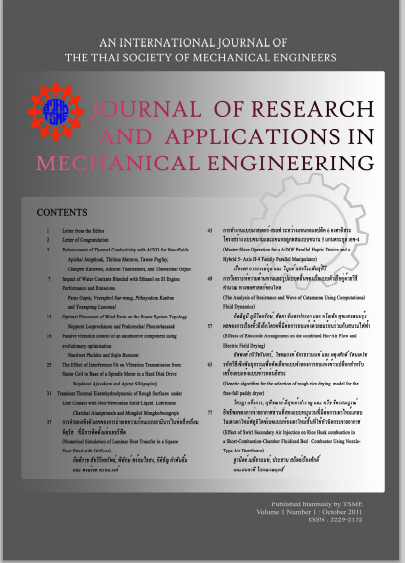Vibration of main components of hard disk drive and the vibrational energy transmission in hard disk drive
Main Article Content
Abstract
This article shows the study of the vibration of 2.5-inch hard disk drive used in a laptop by experimental method. The vibration of the hard disk drive is studied in two ways. First, the modal testing of the main components, which are a top cover, a platter, and the actuator set on the back case with the spindle motor and the vibration testing of the idling hard disk drive are done in order to identify the source of the vibration. The vibration characteristics from the vibration testing are analyzed to find the influence of each component to the occurring vibration. In addition, the relation between the frequency response functions (FRFs) and the natural frequencies of the main components from the modal testing and the vibration characteristics is studied to find the effect of the natural frequencies of each components to the overall system. The study shows that the platter is the main source of the vibration of the hard disk drive. Also, some of the natural frequency of the platter and the actuator set on the back case with the spindle motor maximizes the vibration at that natural frequency. Second, the vibrational energy transferring from the source, found from the first part of this project, modal testing and vibration testing, which is the platter, to other components is studied by using the Statistical Energy Analysis (SEA) principle. A hard disk drive system is separated into three subsystems which are the platter and rotor, the top cover, and the actuator set on the back case with the base of the spindle motor. The SEA parameters, dissipation loss factor and coupling loss factor, are found by experimental method in order to calculate the vibrational transmission energy between each subsystem.
Article Details
This work is licensed under a Creative Commons Attribution-NonCommercial-ShareAlike 4.0 International License.
References
[2] I.Y. Shen. Recent Vibration Issues in Computer Hard Disk Drives. Journal of Magnetism and Magnetic Materials 209 (2000): 6-9.
[3] E. Sarradj. Energy-Based Vibroacoustics: SEA and Beyond. Journal of Sound and Vibration, 2003.
[4] K. Delaere, Statistical Energy Analysis of Acoustic Noise and Vibration for electric motors: transmission from air gap field to motor frame. Industry Application Conference,1999. Thirty-Fourth IAS Annual Meeting. Conference Record of the 1999 IEEE, Vol. 3. pp. 1897-1902.
[5] Cimerman, B., Bharj, T., and Borello, G., Overview of the Experimental Approach to Statistical Energy Analysis, SAE Technical Paper 971968, 1997.
[6] S.S.Rao. Mechanical Vibrations. SI Concersion by Yap Fook Fah. 4th Edition. Singapore: Prentice Hall, 2005.
[7] D.J. Inman. Engineering Vibration. 3rd Edition. United States of America: Pearson Education, Inc, 2008.
[8] R.H. Lyon. Statistical energy analysis of dynamical systems: theory and applications. United States of America: the Massachusetts Institute of Technology, 1975.
[9] C.W. de Silva. Vibration and Shock Handbook. Taylor and Francis Group, LLC, 2005.
[10] J.F. Fieras, J. C. Lai, C. Wang. Noise of Polyphase Electric Motor. Taylor and Francis Group,2006.
[11] The Fundamentals of Signal Analysis. Application Note243. U.S.A.: Hewlett Packard, 1994.
[12] The Fundamentals of Modal testing. Application Note243-3. U.S.A.: Hewlett Packard, 1997.
[13] Bearing Runout Measurements. Application Note 243-7. U.S.A.: Hewlett Packard, 1996.



